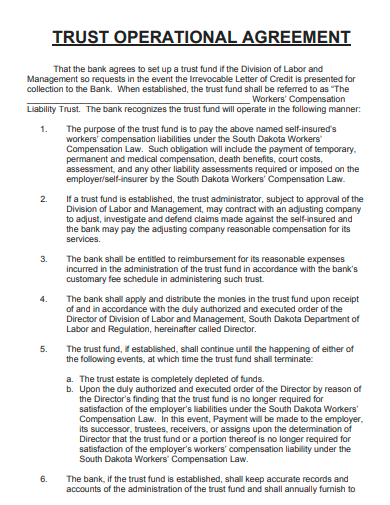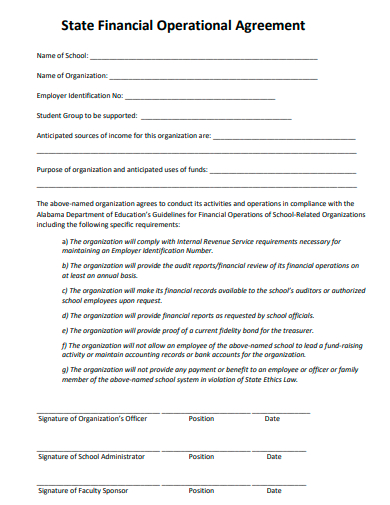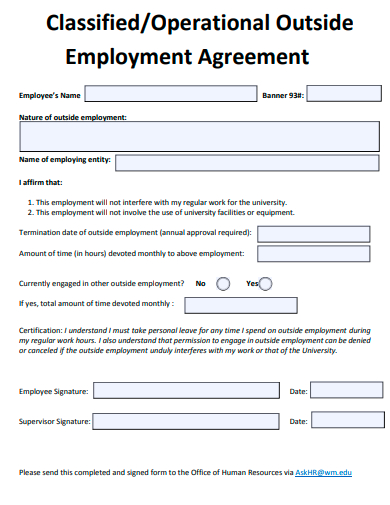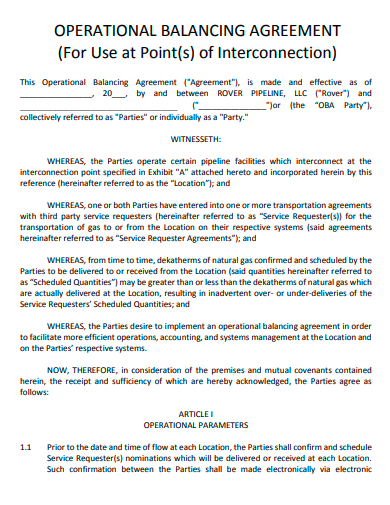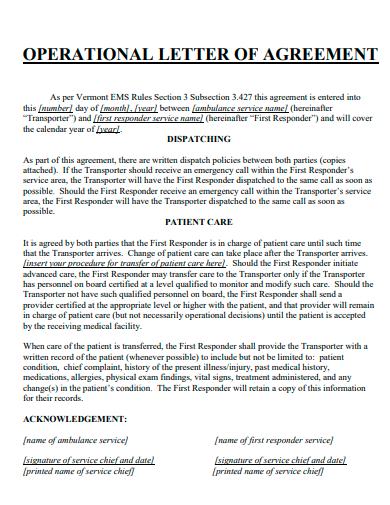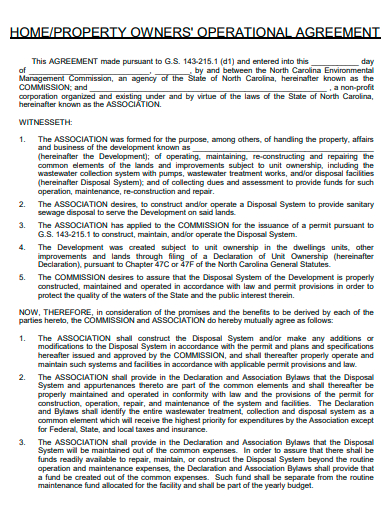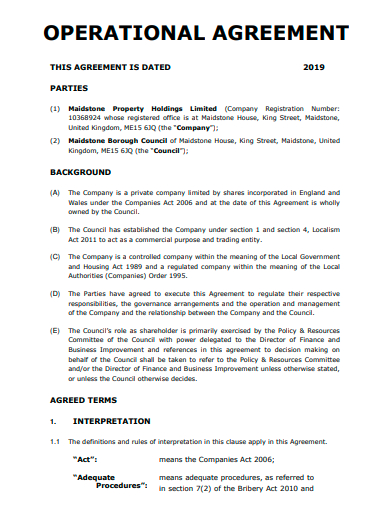There are many distinct varieties of operational agreements, and the particular terms and conditions incorporated into each one will vary according to the particular requirements and performance objectives of the company business. For the sake of illustration, an operating agreement for a business partnership can include specifics like how decisions will be made, how disagreements will be settled, and how small business profits will be distributed. An operating agreement for a non-profit organization may include specifics of how the organization will be supported, how funds will be utilized, and the governance structure in place for the organization.
FREE 10+ Operational Agreement Samples
1. Trust Operational Agreement
2. Operational Medical Director Agreement
3. Operational Agreement Summary
4. Financial Operational Agreement
5. Operational Services Agreement
6. Operational Outside Employment Agreement
7. Operational Balancing Agreement
8. Operational Letter of Agreement
9. Property Owner Operational Agreement
10. Operational Agreement Example
11. Printable Operational Agreement
What Is Operational Agreement?
An operational agreement is a document that outlines the terms and conditions under which a company or organization will operate. It typically includes details about the roles and responsibilities of each member or team within the organization, as well as any policies or procedures that must be followed in order to ensure the smooth and efficient functioning of the organization. Operational agreements can be used in a variety of contexts, including in business partnerships, non-profit organizations, and government agencies. They are often used to help ensure that all members of the organization are on the same page and working towards the same business goals, and can help to prevent misunderstandings or conflicts that may arise due to differing interpretations of the organization’s rules or goals.
How To Make an Operational Agreement?
One of its most important characteristics is that an operational agreement is a legally binding contract. This indicates that all parties who sign the agreement are obligated to conform to the terms and conditions outlined in the document. Should either party fail to do so, it is possible that they will be in breach of the agreement, which may result in inevitable legal repercussions. To facilitate the creation of an operational agreement, the following procedures might be followed:
Step 1- Determine the Purpose
Before you start drafting the agreement, you must understand what you want it to accomplish. What are the goals of the organization? What are the key issues that need to be addressed in the agreement? Having a clear understanding of the agreement’s purpose will help you focus on the most important aspects and ensure that the agreement meets the needs of all parties involved.
Step 2- Identify the Parties
An operational agreement typically involves multiple parties, so it’s important to identify who will be covered by the agreement. This may include individuals, teams, or departments within the organization, as well as any outside parties who will be involved in the organization’s operation.
Step 3- Outline Roles
The operational agreement should clearly define the roles and responsibilities of each party involved in the organization’s operation. This may include details about who is responsible for making decisions, who is responsible for managing certain aspects of the process, and who is responsible for communicating with other parties.
Step 4- Establish Policies
The operating agreement should include details about any policies or procedures that must be followed to ensure the organization’s smooth and efficient functioning. This may include details about how decisions will be made, how conflicts will be resolved, and how information will be shared.
Who is involved in an operational agreement?
An operational agreement typically involves multiple parties, including individuals, teams, or departments within the organization, as well as any outside parties who will be involved in the operation of the organization.
Is an operational agreement legally binding?
Yes, an operational agreement is a legally binding document. This means that all parties who sign the agreement are required to adhere to its terms and conditions. If any party fails to do so, they may be in breach of the agreement, which could lead to legal consequences.
Can an operational agreement be revised or updated?
Yes, operational agreements may need to be revised or updated over time as the needs of the organization change. It’s important to regularly review the agreement and make any necessary updates to ensure that it continues to meet the needs of the organization.
Overall, an operational agreement is an important tool for ensuring that an organization is able to function smoothly and efficiently. It can help to establish clear roles and responsibilities, establish policies and procedures, and provide a framework for decision-making and dispute resolution.
Related Posts
FREE 10+ Trial Agreement Samples In MS Word | Google Docs | Apple Pages | PDF
FREE 9+ Shop Rental Agreement Samples [ Commercial, Lease, Tenancy ]
FREE 10+ Charter Agreement Samples In MS Word | Google Docs | Apple Pages | PDF
FREE 10+ Mentoring Agreement Samples In MS Word | Apple Pages | PDF
FREE 10+ Partner Agreement Samples In MS Word | Google Docs | Apple Pages | PDF
FREE 10+ Individual Agreement Samples In MS Word | Google Docs | Apple Pages | PDF
FREE 10+ Strategic Agreement Samples In MS Word | Google Docs | Apple Pages | PDF
FREE 10+ Equity Agreement Samples In MS Word | Google Docs | Apple Pages | PDF
FREE 10+ Producer Agreement Samples in MS Word | Apple Pages | PDF
FREE 10+ Grant Agreement Samples In MS Word | Apple Pages | PDF
FREE 8+ Meeting Agreement Samples in MS Word | Google Docs | Apple Pages | PDF
FREE 10+ Community Agreement Samples In MS Word | Google Docs | PDF
FREE 8+ Real Estate Option Agreement Samples in MS Word | PDF
FREE 10+ Call Option Agreement Samples In MS Word | PDF
FREE 10+ Advertising Agreement Samples In MS Word | Google Docs | Apple Pages | PDF

